Research articles
A virally-encoded trna neutralizes the paris antiviral defence system.
- Nathaniel Burman
- Svetlana Belukhina
- Artem Isaev


Structure of the human dopamine transporter and mechanisms of inhibition
Cryo-electron microscopy structure of the human dopamine transporter in complex with multiple inhibitors illuminates mechanisms of allosteric inhibition.
- Dushyant Kumar Srivastava
- Vikas Navratna
- Eric Gouaux
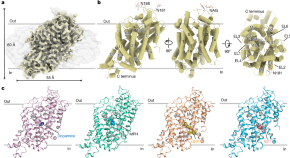
Dopamine reuptake and inhibitory mechanisms in human dopamine transporter
Structural analyses of the human dopamine transporter in apo and substrate-bound states and in complex with drugs and inhibitors reveal key binding residues and conformational transitions that occur during substrate transport.
- Xianping Wang
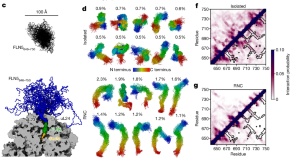
The ribosome lowers the entropic penalty of protein folding
Structures of the growing peptide chain on and off the ribosome reveal that the ribosome destabilizes the unfolded nascent chain, promoting the formation of partially folded intermediate states.
- Julian O. Streit
- Ivana V. Bukvin
- John Christodoulou
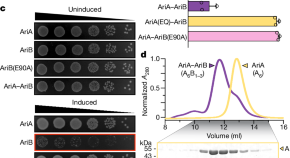
Architecture and activation mechanism of the bacterial PARIS defence system
The bacterial phage anti-restriction-induced system, PARIS, operates as a toxin–antitoxin system, in which the antitoxin AriA sequesters and inactivates the toxin AriB until triggered by the T7 phage counterdefence protein Ocr.
- Qishan Liang
- Kevin D. Corbett
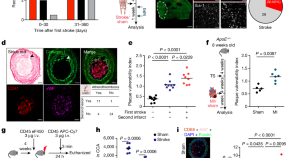
DNA-sensing inflammasomes cause recurrent atherosclerotic stroke
This study describes sensing of circulating cell-free DNA after stroke as the mechanism leading to recurrent ischemic events.
- Stefan Roth
- Arthur Liesz
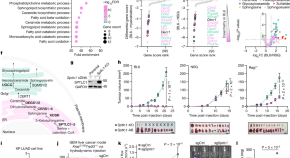
Glycosphingolipid synthesis mediates immune evasion in KRAS -driven cancer
Functional genomics and lipidomic analyses reveal that sphingolipid synthesis is required for tumour immune evasion and tumour growth in vivo, mediated in part by the impact of glycosphingolipid synthesis on cell surface expression of IFNγ receptors.
- Mariluz Soula
- Gokhan Unlu
- Kıvanç Birsoy

A nebular origin for the persistent radio emission of fast radio bursts
Observations of a third, less luminous persistent radio source associated with the repeating fast radio burst FRB 20201124A indicate that the burst originates from a young magnetar surrounded by a nebula of ionized gas.
- Gabriele Bruni
- Rosita Paladino
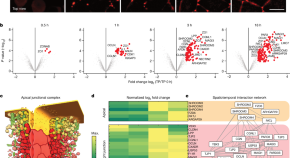
Membrane prewetting by condensates promotes tight-junction belt formation
Experimental and theoretical results demonstrate that tight-junction formation depends on the growth of a condensed layer of ZO-1 proteins at the interface of the apical and lateral membrane, providing insight into self-assembly of complex mesoscale structures in cells.
- Karina Pombo-García
- Omar Adame-Arana
- Alf Honigmann
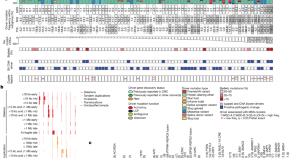
The genomic landscape of 2,023 colorectal cancers
Whole-genome sequencing of more than 2,000 colorectal carcinoma samples provides a highly detailed view of the genomic landscape of this cancer and identifies new driver mutations.
- Alex J. Cornish
- Andreas J. Gruber
- Richard S. Houlston

PTER is a N -acetyltaurine hydrolase that regulates feeding and obesity
The orphan enzyme phosphotriesterase-related (PTER) is identified as a mammalian N -acetyltaurine hydrolase that has roles in regulating body weight and energy balance.
- Jonathan Z. Long
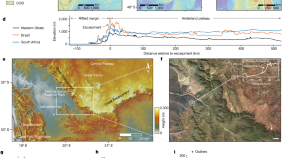
Coevolution of craton margins and interiors during continental break-up
By integrating geological observations, statistical analysis, geodynamic simulations and landscape-evolution models, a physical model is proposed to link the coevolution of craton margins and interiors with continental rifting.
- Thomas M. Gernon
- Thea K. Hincks
- Anne Glerum
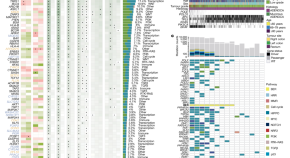
Prognostic genome and transcriptome signatures in colorectal cancers
A large integrated genome and transcriptome analysis of colorectal cancer identifies prognostic mutations and expression subtypes.
- Tobias Sjöblom
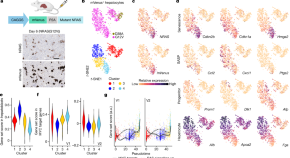
Titration of RAS alters senescent state and influences tumour initiation
Oncogenic RAS dose-escalation models are used to explore how the level of RAS determines whether cells enter a senescent state or have tumour-initiating activity.
- Adelyne S. L. Chan
- Masashi Narita
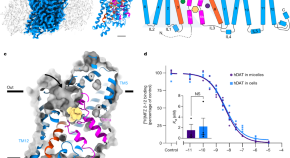
Structure of the human dopamine transporter in complex with cocaine
A study using cryo-electron microscopy has determined the structure of the human dopamine transporter with bound cocaine, revealing molecular details about neurotransmitter transport and how it is affected by neuropsychiatric drugs.
- Jeppe C. Nielsen
- Kristine Salomon
- Claus J. Loland
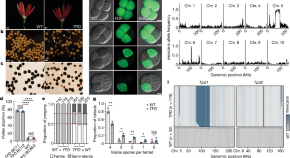
Teosinte Pollen Drive guides maize diversification and domestication by RNAi
An example of hybrid incompatibility between maize and teosinte reveals a selfish toxin–antidote system mediated by small RNAs that may have contributed to the origin of maize.
- Benjamin Berube
- Robert A. Martienssen
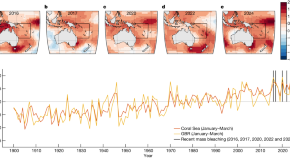
Highest ocean heat in four centuries places Great Barrier Reef in danger
High ocean temperatures that caused mass coral bleaching and mortality on the Great Barrier Reef in the past decade are the warmest in 400 years and are the result of human-caused climate change.
- Benjamin J. Henley
- Helen V. McGregor
- Braddock K. Linsley
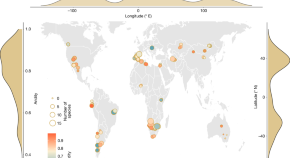
Unforeseen plant phenotypic diversity in a dry and grazed world
Analysis of 20 chemical and morphological plant traits at diverse sites across 6 continents shows that the transition from semi-arid to arid zones is associated with an unexpected 88% increase in trait diversity.
- Nicolas Gross
- Fernando T. Maestre
- Yoann Le Bagousse-Pinguet
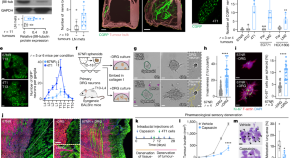
Neuronal substance P drives metastasis through an extracellular RNA–TLR7 axis
Hyperactivation of sensory neurons regulates multiple aspects of metastatic progression in breast cancer.
- Veena Padmanaban
- Isabel Keller
- Sohail F. Tavazoie

Single-crystalline metal-oxide dielectrics for top-gate 2D transistors
By using intercalative oxidation techniques, stable, stoichiometric and atomically thin single-crystalline Al 2 O 3 films can be produced, which can be effectively used as a dielectric in top-gated field-effect transistors based on two-dimensional materials.
- Daobing Zeng
- Ziyang Zhang
- Zengfeng Di
Quick links
- Explore articles by subject
- Guide to authors
- Editorial policies
This website uses cookies to ensure you get the best experience. Learn more about DOAJ’s privacy policy.
Hide this message
You are using an outdated browser. Please upgrade your browser to improve your experience and security.
The Directory of Open Access Journals
Directory of Open Access Journals
Find open access journals & articles.
Doaj in numbers.
80 languages
134 countries represented
13,689 journals without APCs
20,765 journals
10,396,750 article records
Quick search
About the directory.
DOAJ is a unique and extensive index of diverse open access journals from around the world, driven by a growing community, and is committed to ensuring quality content is freely available online for everyone.
DOAJ is committed to keeping its services free of charge, including being indexed, and its data freely available.
→ About DOAJ
→ How to apply
DOAJ is twenty years old in 2023.
Fund our 20th anniversary campaign
DOAJ is independent. All support is via donations.
82% from academic organisations
18% from contributors
Support DOAJ
Publishers don't need to donate to be part of DOAJ.
News Service
Meet the doaj team: head of editorial and deputy head of editorial (quality), vacancy: operations manager, press release: pubscholar joins the movement to support the directory of open access journals, new major version of the api to be released.
→ All blog posts
We would not be able to work without our volunteers, such as these top-performing editors and associate editors.
→ Meet our volunteers
Librarianship, Scholarly Publishing, Data Management
Brisbane, Australia (Chinese, English)
Adana, Türkiye (Turkish, English)
Humanities, Social Sciences
Natalia Pamuła
Toruń, Poland (Polish, English)
Medical Sciences, Nutrition
Pablo Hernandez
Caracas, Venezuela (Spanish, English)
Research Evaluation
Paola Galimberti
Milan, Italy (Italian, German, English)
Social Sciences, Humanities
Dawam M. Rohmatulloh
Ponorogo, Indonesia (Bahasa Indonesia, English, Dutch)
Systematic Entomology
Kadri Kıran
Edirne, Türkiye (English, Turkish, German)
Library and Information Science
Nataliia Kaliuzhna
Kyiv, Ukraine (Ukrainian, Russian, English, Polish)
WeChat QR code

Discover the world's scientific knowledge
With 160+ million publication pages, 25+ million researchers and 1+ million questions, this is where everyone can access science.
You can use AND, OR, NOT, "" and () to specify your search.
- Consent preferences
- Find journals
- My journals
Register Sign in
Register or sign-in in order to manage your journal lists
Sign in or register to save a journal
To save a journal and create lists, you need to sign in to your Elsevier account.
Find the right journal for your research
Looking for the best journal match for your paper? Search the world's leading source of academic journals using your abstract or your keywords and other details.
Check if you're eligible for open access (OA) savings.

Explore millions of high-quality primary sources and images from around the world, including artworks, maps, photographs, and more.
Explore migration issues through a variety of media types
- Part of The Streets are Talking: Public Forms of Creative Expression from Around the World
- Part of The Journal of Economic Perspectives, Vol. 34, No. 1 (Winter 2020)
- Part of Cato Institute (Aug. 3, 2021)
- Part of University of California Press
- Part of Open: Smithsonian National Museum of African American History & Culture
- Part of Indiana Journal of Global Legal Studies, Vol. 19, No. 1 (Winter 2012)
- Part of R Street Institute (Nov. 1, 2020)
- Part of Leuven University Press
- Part of UN Secretary-General Papers: Ban Ki-moon (2007-2016)
- Part of Perspectives on Terrorism, Vol. 12, No. 4 (August 2018)
- Part of Leveraging Lives: Serbia and Illegal Tunisian Migration to Europe, Carnegie Endowment for International Peace (Mar. 1, 2023)
- Part of UCL Press
Harness the power of visual materials—explore more than 3 million images now on JSTOR.
Enhance your scholarly research with underground newspapers, magazines, and journals.
Explore collections in the arts, sciences, and literature from the world’s leading museums, archives, and scholars.
How to Write and Publish a Research Paper for a Peer-Reviewed Journal
- Open access
- Published: 30 April 2020
- Volume 36 , pages 909–913, ( 2021 )
Cite this article
You have full access to this open access article

- Clara Busse ORCID: orcid.org/0000-0002-0178-1000 1 &
- Ella August ORCID: orcid.org/0000-0001-5151-1036 1 , 2
279k Accesses
15 Citations
710 Altmetric
Explore all metrics
Communicating research findings is an essential step in the research process. Often, peer-reviewed journals are the forum for such communication, yet many researchers are never taught how to write a publishable scientific paper. In this article, we explain the basic structure of a scientific paper and describe the information that should be included in each section. We also identify common pitfalls for each section and recommend strategies to avoid them. Further, we give advice about target journal selection and authorship. In the online resource 1 , we provide an example of a high-quality scientific paper, with annotations identifying the elements we describe in this article.
Similar content being viewed by others

How to Choose the Right Journal

The Point Is…to Publish?

Writing and publishing a scientific paper
Avoid common mistakes on your manuscript.
Introduction
Writing a scientific paper is an important component of the research process, yet researchers often receive little formal training in scientific writing. This is especially true in low-resource settings. In this article, we explain why choosing a target journal is important, give advice about authorship, provide a basic structure for writing each section of a scientific paper, and describe common pitfalls and recommendations for each section. In the online resource 1 , we also include an annotated journal article that identifies the key elements and writing approaches that we detail here. Before you begin your research, make sure you have ethical clearance from all relevant ethical review boards.
Select a Target Journal Early in the Writing Process
We recommend that you select a “target journal” early in the writing process; a “target journal” is the journal to which you plan to submit your paper. Each journal has a set of core readers and you should tailor your writing to this readership. For example, if you plan to submit a manuscript about vaping during pregnancy to a pregnancy-focused journal, you will need to explain what vaping is because readers of this journal may not have a background in this topic. However, if you were to submit that same article to a tobacco journal, you would not need to provide as much background information about vaping.
Information about a journal’s core readership can be found on its website, usually in a section called “About this journal” or something similar. For example, the Journal of Cancer Education presents such information on the “Aims and Scope” page of its website, which can be found here: https://www.springer.com/journal/13187/aims-and-scope .
Peer reviewer guidelines from your target journal are an additional resource that can help you tailor your writing to the journal and provide additional advice about crafting an effective article [ 1 ]. These are not always available, but it is worth a quick web search to find out.
Identify Author Roles Early in the Process
Early in the writing process, identify authors, determine the order of authors, and discuss the responsibilities of each author. Standard author responsibilities have been identified by The International Committee of Medical Journal Editors (ICMJE) [ 2 ]. To set clear expectations about each team member’s responsibilities and prevent errors in communication, we also suggest outlining more detailed roles, such as who will draft each section of the manuscript, write the abstract, submit the paper electronically, serve as corresponding author, and write the cover letter. It is best to formalize this agreement in writing after discussing it, circulating the document to the author team for approval. We suggest creating a title page on which all authors are listed in the agreed-upon order. It may be necessary to adjust authorship roles and order during the development of the paper. If a new author order is agreed upon, be sure to update the title page in the manuscript draft.
In the case where multiple papers will result from a single study, authors should discuss who will author each paper. Additionally, authors should agree on a deadline for each paper and the lead author should take responsibility for producing an initial draft by this deadline.
Structure of the Introduction Section
The introduction section should be approximately three to five paragraphs in length. Look at examples from your target journal to decide the appropriate length. This section should include the elements shown in Fig. 1 . Begin with a general context, narrowing to the specific focus of the paper. Include five main elements: why your research is important, what is already known about the topic, the “gap” or what is not yet known about the topic, why it is important to learn the new information that your research adds, and the specific research aim(s) that your paper addresses. Your research aim should address the gap you identified. Be sure to add enough background information to enable readers to understand your study. Table 1 provides common introduction section pitfalls and recommendations for addressing them.

The main elements of the introduction section of an original research article. Often, the elements overlap
Methods Section
The purpose of the methods section is twofold: to explain how the study was done in enough detail to enable its replication and to provide enough contextual detail to enable readers to understand and interpret the results. In general, the essential elements of a methods section are the following: a description of the setting and participants, the study design and timing, the recruitment and sampling, the data collection process, the dataset, the dependent and independent variables, the covariates, the analytic approach for each research objective, and the ethical approval. The hallmark of an exemplary methods section is the justification of why each method was used. Table 2 provides common methods section pitfalls and recommendations for addressing them.
Results Section
The focus of the results section should be associations, or lack thereof, rather than statistical tests. Two considerations should guide your writing here. First, the results should present answers to each part of the research aim. Second, return to the methods section to ensure that the analysis and variables for each result have been explained.
Begin the results section by describing the number of participants in the final sample and details such as the number who were approached to participate, the proportion who were eligible and who enrolled, and the number of participants who dropped out. The next part of the results should describe the participant characteristics. After that, you may organize your results by the aim or by putting the most exciting results first. Do not forget to report your non-significant associations. These are still findings.
Tables and figures capture the reader’s attention and efficiently communicate your main findings [ 3 ]. Each table and figure should have a clear message and should complement, rather than repeat, the text. Tables and figures should communicate all salient details necessary for a reader to understand the findings without consulting the text. Include information on comparisons and tests, as well as information about the sample and timing of the study in the title, legend, or in a footnote. Note that figures are often more visually interesting than tables, so if it is feasible to make a figure, make a figure. To avoid confusing the reader, either avoid abbreviations in tables and figures, or define them in a footnote. Note that there should not be citations in the results section and you should not interpret results here. Table 3 provides common results section pitfalls and recommendations for addressing them.
Discussion Section
Opposite the introduction section, the discussion should take the form of a right-side-up triangle beginning with interpretation of your results and moving to general implications (Fig. 2 ). This section typically begins with a restatement of the main findings, which can usually be accomplished with a few carefully-crafted sentences.

Major elements of the discussion section of an original research article. Often, the elements overlap
Next, interpret the meaning or explain the significance of your results, lifting the reader’s gaze from the study’s specific findings to more general applications. Then, compare these study findings with other research. Are these findings in agreement or disagreement with those from other studies? Does this study impart additional nuance to well-accepted theories? Situate your findings within the broader context of scientific literature, then explain the pathways or mechanisms that might give rise to, or explain, the results.
Journals vary in their approach to strengths and limitations sections: some are embedded paragraphs within the discussion section, while some mandate separate section headings. Keep in mind that every study has strengths and limitations. Candidly reporting yours helps readers to correctly interpret your research findings.
The next element of the discussion is a summary of the potential impacts and applications of the research. Should these results be used to optimally design an intervention? Does the work have implications for clinical protocols or public policy? These considerations will help the reader to further grasp the possible impacts of the presented work.
Finally, the discussion should conclude with specific suggestions for future work. Here, you have an opportunity to illuminate specific gaps in the literature that compel further study. Avoid the phrase “future research is necessary” because the recommendation is too general to be helpful to readers. Instead, provide substantive and specific recommendations for future studies. Table 4 provides common discussion section pitfalls and recommendations for addressing them.
Follow the Journal’s Author Guidelines
After you select a target journal, identify the journal’s author guidelines to guide the formatting of your manuscript and references. Author guidelines will often (but not always) include instructions for titles, cover letters, and other components of a manuscript submission. Read the guidelines carefully. If you do not follow the guidelines, your article will be sent back to you.
Finally, do not submit your paper to more than one journal at a time. Even if this is not explicitly stated in the author guidelines of your target journal, it is considered inappropriate and unprofessional.
Your title should invite readers to continue reading beyond the first page [ 4 , 5 ]. It should be informative and interesting. Consider describing the independent and dependent variables, the population and setting, the study design, the timing, and even the main result in your title. Because the focus of the paper can change as you write and revise, we recommend you wait until you have finished writing your paper before composing the title.
Be sure that the title is useful for potential readers searching for your topic. The keywords you select should complement those in your title to maximize the likelihood that a researcher will find your paper through a database search. Avoid using abbreviations in your title unless they are very well known, such as SNP, because it is more likely that someone will use a complete word rather than an abbreviation as a search term to help readers find your paper.
After you have written a complete draft, use the checklist (Fig. 3 ) below to guide your revisions and editing. Additional resources are available on writing the abstract and citing references [ 5 ]. When you feel that your work is ready, ask a trusted colleague or two to read the work and provide informal feedback. The box below provides a checklist that summarizes the key points offered in this article.

Checklist for manuscript quality
Data Availability
Michalek AM (2014) Down the rabbit hole…advice to reviewers. J Cancer Educ 29:4–5
Article Google Scholar
International Committee of Medical Journal Editors. Defining the role of authors and contributors: who is an author? http://www.icmje.org/recommendations/browse/roles-and-responsibilities/defining-the-role-of-authosrs-and-contributors.html . Accessed 15 January, 2020
Vetto JT (2014) Short and sweet: a short course on concise medical writing. J Cancer Educ 29(1):194–195
Brett M, Kording K (2017) Ten simple rules for structuring papers. PLoS ComputBiol. https://doi.org/10.1371/journal.pcbi.1005619
Lang TA (2017) Writing a better research article. J Public Health Emerg. https://doi.org/10.21037/jphe.2017.11.06
Download references
Acknowledgments
Ella August is grateful to the Sustainable Sciences Institute for mentoring her in training researchers on writing and publishing their research.
Code Availability
Not applicable.
Author information
Authors and affiliations.
Department of Maternal and Child Health, University of North Carolina Gillings School of Global Public Health, 135 Dauer Dr, 27599, Chapel Hill, NC, USA
Clara Busse & Ella August
Department of Epidemiology, University of Michigan School of Public Health, 1415 Washington Heights, Ann Arbor, MI, 48109-2029, USA
Ella August
You can also search for this author in PubMed Google Scholar
Corresponding author
Correspondence to Ella August .
Ethics declarations
Conflicts of interests.
The authors declare that they have no conflict of interest.
Additional information
Publisher’s note.
Springer Nature remains neutral with regard to jurisdictional claims in published maps and institutional affiliations.
Electronic supplementary material
(PDF 362 kb)
Rights and permissions
Open Access This article is licensed under a Creative Commons Attribution 4.0 International License, which permits use, sharing, adaptation, distribution and reproduction in any medium or format, as long as you give appropriate credit to the original author(s) and the source, provide a link to the Creative Commons licence, and indicate if changes were made. The images or other third party material in this article are included in the article's Creative Commons licence, unless indicated otherwise in a credit line to the material. If material is not included in the article's Creative Commons licence and your intended use is not permitted by statutory regulation or exceeds the permitted use, you will need to obtain permission directly from the copyright holder. To view a copy of this licence, visit http://creativecommons.org/licenses/by/4.0/ .
Reprints and permissions
About this article
Busse, C., August, E. How to Write and Publish a Research Paper for a Peer-Reviewed Journal. J Canc Educ 36 , 909–913 (2021). https://doi.org/10.1007/s13187-020-01751-z
Download citation
Published : 30 April 2020
Issue Date : October 2021
DOI : https://doi.org/10.1007/s13187-020-01751-z
Share this article
Anyone you share the following link with will be able to read this content:
Sorry, a shareable link is not currently available for this article.
Provided by the Springer Nature SharedIt content-sharing initiative
- Manuscripts
- Scientific writing
- Find a journal
- Publish with us
- Track your research
Grab your spot at the free arXiv Accessibility Forum
Help | Advanced Search
arXiv is a free distribution service and an open-access archive for nearly 2.4 million scholarly articles in the fields of physics, mathematics, computer science, quantitative biology, quantitative finance, statistics, electrical engineering and systems science, and economics. Materials on this site are not peer-reviewed by arXiv.
arXiv is a free distribution service and an open-access archive for scholarly articles in the fields of physics, mathematics, computer science, quantitative biology, quantitative finance, statistics, electrical engineering and systems science, and economics. Materials on this site are not peer-reviewed by arXiv.
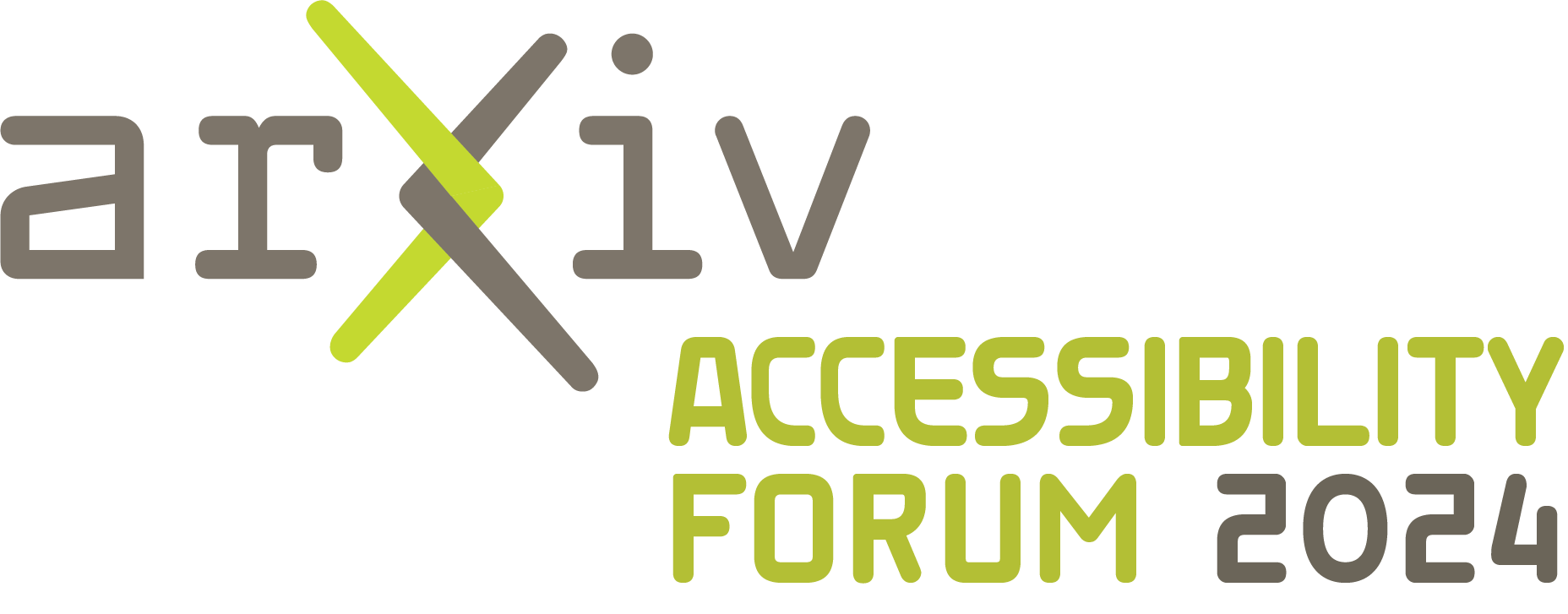
arXiv Accessibility Forum
Accessibility means access regardless of disability. Join arXiv and global experts this September at the Forum focused on accessibility of scientific research. Learn more .
- Astrophysics ( astro-ph new , recent , search ) Astrophysics of Galaxies ; Cosmology and Nongalactic Astrophysics ; Earth and Planetary Astrophysics ; High Energy Astrophysical Phenomena ; Instrumentation and Methods for Astrophysics ; Solar and Stellar Astrophysics
- Condensed Matter ( cond-mat new , recent , search ) Disordered Systems and Neural Networks ; Materials Science ; Mesoscale and Nanoscale Physics ; Other Condensed Matter ; Quantum Gases ; Soft Condensed Matter ; Statistical Mechanics ; Strongly Correlated Electrons ; Superconductivity
- General Relativity and Quantum Cosmology ( gr-qc new , recent , search )
- High Energy Physics - Experiment ( hep-ex new , recent , search )
- High Energy Physics - Lattice ( hep-lat new , recent , search )
- High Energy Physics - Phenomenology ( hep-ph new , recent , search )
- High Energy Physics - Theory ( hep-th new , recent , search )
- Mathematical Physics ( math-ph new , recent , search )
- Nonlinear Sciences ( nlin new , recent , search ) includes: Adaptation and Self-Organizing Systems ; Cellular Automata and Lattice Gases ; Chaotic Dynamics ; Exactly Solvable and Integrable Systems ; Pattern Formation and Solitons
- Nuclear Experiment ( nucl-ex new , recent , search )
- Nuclear Theory ( nucl-th new , recent , search )
- Physics ( physics new , recent , search ) includes: Accelerator Physics ; Applied Physics ; Atmospheric and Oceanic Physics ; Atomic and Molecular Clusters ; Atomic Physics ; Biological Physics ; Chemical Physics ; Classical Physics ; Computational Physics ; Data Analysis, Statistics and Probability ; Fluid Dynamics ; General Physics ; Geophysics ; History and Philosophy of Physics ; Instrumentation and Detectors ; Medical Physics ; Optics ; Physics and Society ; Physics Education ; Plasma Physics ; Popular Physics ; Space Physics
- Quantum Physics ( quant-ph new , recent , search )
Mathematics
- Mathematics ( math new , recent , search ) includes: (see detailed description ): Algebraic Geometry ; Algebraic Topology ; Analysis of PDEs ; Category Theory ; Classical Analysis and ODEs ; Combinatorics ; Commutative Algebra ; Complex Variables ; Differential Geometry ; Dynamical Systems ; Functional Analysis ; General Mathematics ; General Topology ; Geometric Topology ; Group Theory ; History and Overview ; Information Theory ; K-Theory and Homology ; Logic ; Mathematical Physics ; Metric Geometry ; Number Theory ; Numerical Analysis ; Operator Algebras ; Optimization and Control ; Probability ; Quantum Algebra ; Representation Theory ; Rings and Algebras ; Spectral Theory ; Statistics Theory ; Symplectic Geometry
Computer Science
- Computing Research Repository ( CoRR new , recent , search ) includes: (see detailed description ): Artificial Intelligence ; Computation and Language ; Computational Complexity ; Computational Engineering, Finance, and Science ; Computational Geometry ; Computer Science and Game Theory ; Computer Vision and Pattern Recognition ; Computers and Society ; Cryptography and Security ; Data Structures and Algorithms ; Databases ; Digital Libraries ; Discrete Mathematics ; Distributed, Parallel, and Cluster Computing ; Emerging Technologies ; Formal Languages and Automata Theory ; General Literature ; Graphics ; Hardware Architecture ; Human-Computer Interaction ; Information Retrieval ; Information Theory ; Logic in Computer Science ; Machine Learning ; Mathematical Software ; Multiagent Systems ; Multimedia ; Networking and Internet Architecture ; Neural and Evolutionary Computing ; Numerical Analysis ; Operating Systems ; Other Computer Science ; Performance ; Programming Languages ; Robotics ; Social and Information Networks ; Software Engineering ; Sound ; Symbolic Computation ; Systems and Control
Quantitative Biology
- Quantitative Biology ( q-bio new , recent , search ) includes: (see detailed description ): Biomolecules ; Cell Behavior ; Genomics ; Molecular Networks ; Neurons and Cognition ; Other Quantitative Biology ; Populations and Evolution ; Quantitative Methods ; Subcellular Processes ; Tissues and Organs
Quantitative Finance
- Quantitative Finance ( q-fin new , recent , search ) includes: (see detailed description ): Computational Finance ; Economics ; General Finance ; Mathematical Finance ; Portfolio Management ; Pricing of Securities ; Risk Management ; Statistical Finance ; Trading and Market Microstructure
- Statistics ( stat new , recent , search ) includes: (see detailed description ): Applications ; Computation ; Machine Learning ; Methodology ; Other Statistics ; Statistics Theory
Electrical Engineering and Systems Science
- Electrical Engineering and Systems Science ( eess new , recent , search ) includes: (see detailed description ): Audio and Speech Processing ; Image and Video Processing ; Signal Processing ; Systems and Control
- Economics ( econ new , recent , search ) includes: (see detailed description ): Econometrics ; General Economics ; Theoretical Economics
About arXiv
- General information
- How to Submit to arXiv
- Membership & Giving
An official website of the United States government
The .gov means it’s official. Federal government websites often end in .gov or .mil. Before sharing sensitive information, make sure you’re on a federal government site.
The site is secure. The https:// ensures that you are connecting to the official website and that any information you provide is encrypted and transmitted securely.
- Publications
- Account settings
Trending Articles
- Neutrophil trapping and nexocytosis, mast cell-mediated processes for inflammatory signal relay. Mihlan M, et al. Cell. 2024. PMID: 39096902
- Dementia prevention, intervention, and care: 2024 report of the Lancet standing Commission. Livingston G, et al. Lancet. 2024. PMID: 39096926 Review. No abstract available.
- The FXR1 network acts as a signaling scaffold for actomyosin remodeling. Chen X, et al. Cell. 2024. PMID: 39106863
- The traditional Chinese medicine Qiliqiangxin in heart failure with reduced ejection fraction: a randomized, double-blind, placebo-controlled trial. Cheang I, et al. Nat Med. 2024. PMID: 39095596
- A microbial metabolite inhibits the HIF-2α-ceramide pathway to mediate the beneficial effects of time-restricted feeding on MASH. Zhang Y, et al. Cell Metab. 2024. PMID: 39079531
Latest Literature
- Diabetes Care (2)
- J Clin Endocrinol Metab (6)
- J Immunol (3)
- J Neurosci (3)
- PLoS One (59)
- Pediatrics (2)
- Proc Natl Acad Sci U S A (15)
NCBI Literature Resources
MeSH PMC Bookshelf Disclaimer
The PubMed wordmark and PubMed logo are registered trademarks of the U.S. Department of Health and Human Services (HHS). Unauthorized use of these marks is strictly prohibited.
- {{link.text}}
Publications
Google publishes hundreds of research papers each year. Publishing is important to us; it enables us to collaborate and share ideas with, as well as learn from, the broader scientific community. Submissions are often made stronger by the fact that ideas have been tested through real product implementation by the time of publication.
We believe the formal structures of publishing today are changing - in computer science especially, there are multiple ways of disseminating information. We encourage publication both in conventional scientific venues, and through other venues such as industry forums, standards bodies, and open source software and product feature releases.
Open Source
We understand the value of a collaborative ecosystem and love open source software .
Product and Feature Launches
With every launch, we're publishing progress and pushing functionality.
Industry Standards
Our researchers are often helping to define not just today's products but also tomorrow's.
"Resources" doesn't just mean tangible assets but also intellectual. Incredible datasets and a great team of colleagues foster a rich and collaborative research environment.
Couple big challenges with big resources and Google offers unprecedented research opportunities.
22 Research Areas
- Algorithms and Theory 608 Publications
- Data Management 116 Publications
- Data Mining and Modeling 214 Publications
- Distributed Systems and Parallel Computing 208 Publications
- Economics and Electronic Commerce 209 Publications
- Education Innovation 30 Publications
- General Science 158 Publications
- Hardware and Architecture 67 Publications
- Human-Computer Interaction and Visualization 444 Publications
- Information Retrieval and the Web 213 Publications
- Machine Intelligence 1019 Publications
- Machine Perception 454 Publications
- Machine Translation 48 Publications
- Mobile Systems 72 Publications
- Natural Language Processing 395 Publications
- Networking 210 Publications
- Quantum A.I. 30 Publications
- Robotics 37 Publications
- Security, Privacy and Abuse Prevention 289 Publications
- Software Engineering 100 Publications
- Software Systems 250 Publications
- Speech Processing 264 Publications
3 Collections
- Google AI Residency 60 Publications
- Google Brain Team 305 Publications
- Data Infrastructure and Analysis 10 Publications
Academia.edu no longer supports Internet Explorer.
To browse Academia.edu and the wider internet faster and more securely, please take a few seconds to upgrade your browser .
Download 55 million PDFs for free
Explore our top research interests.


Engineering

Anthropology

- Earth Sciences

- Computer Science

- Mathematics

- Health Sciences

Join 267 million academics and researchers
Track your impact.
Share your work with other academics, grow your audience and track your impact on your field with our robust analytics
Discover new research
Get access to millions of research papers and stay informed with the important topics around the world
Publish your work
Publish your research with fast and rigorous service through Academia.edu Journals. Get instant worldwide dissemination of your work
Unlock the most powerful tools with Academia Premium

Work faster and smarter with advanced research discovery tools
Search the full text and citations of our millions of papers. Download groups of related papers to jumpstart your research. Save time with detailed summaries and search alerts.
- Advanced Search
- PDF Packages of 37 papers
- Summaries and Search Alerts

Share your work, track your impact, and grow your audience
Get notified when other academics mention you or cite your papers. Track your impact with in-depth analytics and network with members of your field.
- Mentions and Citations Tracking
- Advanced Analytics
- Publishing Tools
Real stories from real people

Used by academics at over 15,000 universities

Get started and find the best quality research
- Academia.edu Journals
- We're Hiring!
- Help Center
- Find new research papers in:
- Cognitive Science
- Academia ©2024
Find the right journal
If you know the name of the journal you want to submit to, view all journals .
If you would like us to recommend the journal/s that are best suited to publish your article, use our Journal Suggester . All you need is an abstract or description of your article to find matching journals.
Tips for finding the right journal
Submitting a manuscript to unsuitable journals is a common mistake, and can cause journal editors to reject the manuscript before peer review. Choosing a relevant journal makes it more likely that your manuscript will be accepted. Some factors to consider are:
- The topics the journal publishes. If your research is applied, target a journal that publishes applied science; if it is clinical, target a clinical journal; if it is basic research, target a journal that publishes basic research. You may find it easier to browse a list of journals by subject area.
- The journal's audience. Will researchers in related fields be interested in your study? If so, a journal that covers a broad range of topics may be best. If only researchers in your field are likely to want to read your study, then a field-specific journal would be best.
- The types of articles the journal publishes. If you are looking to publish a review, case study or a theorem, ensure that your target journal accepts theses type of manuscripts.
- The reputation of the journal. A journal's Impact Factor is one measure of its reputation, but not always the most important. You should consider the prestige of the authors that publish in the journal and whether your research is of a similar level.
- What are your personal requirements: Does the journal usually publish articles quickly; is the "time to publication" important for you?
When looking for suitable journals in which to publish your own results, start with what you have read. You should already be familiar with published studies that are similar to yours. Which journal were those studies published in? The same journals may be appropriate for your manuscript, so make a list of them. If you need more journals to consider, you can do literature searches for other published articles in your field that are similar in scope and impact on the field, and see where they were published.
When you have a list of potential target journals, visit and read the websites for these journals. Every journal should have a page that provides instructions for authors, including information on many of the factors listed above.
Journals on your list that are not a match for your manuscript based on the factors listed above should be eliminated from consideration. Among the remaining journals, it is likely that one or more will stand out as a very good candidate. Consider if any additional experiments will give you a better chance of achieving publication in your top choice. If you are in a hurry to publish, consider which of the remaining journals offers rapid publication; if none do, consider which has the highest publication frequency. If your main goal is to reach as many readers as possible, strongly consider candidate journals that provide an open access option. Open access allows anyone to read your article, free of charge, online, which can make your article more likely to be read and cited.
When you have chosen the journal you think is the best fit for your study and your goals, it is usually a good idea to also identify your second- and third-choice journals. That way, if your paper is rejected from your first-choice journal, you can quickly submit to your second-choice journal.
- Advanced search
- Peer review

Discover relevant research today

Advance your research field in the open

Reach new audiences and maximize your readership
ScienceOpen puts your research in the context of
Publications
For Publishers
ScienceOpen offers content hosting, context building and marketing services for publishers. See our tailored offerings
- For academic publishers to promote journals and interdisciplinary collections
- For open access journals to host journal content in an interactive environment
- For university library publishing to develop new open access paradigms for their scholars
- For scholarly societies to promote content with interactive features
For Institutions
ScienceOpen offers state-of-the-art technology and a range of solutions and services
- For faculties and research groups to promote and share your work
- For research institutes to build up your own branding for OA publications
- For funders to develop new open access publishing paradigms
- For university libraries to create an independent OA publishing environment
For Researchers
Make an impact and build your research profile in the open with ScienceOpen
- Search and discover relevant research in over 95 million Open Access articles and article records
- Share your expertise and get credit by publicly reviewing any article
- Publish your poster or preprint and track usage and impact with article- and author-level metrics
- Create a topical Collection to advance your research field
Create a Journal powered by ScienceOpen
Launching a new open access journal or an open access press? ScienceOpen now provides full end-to-end open access publishing solutions – embedded within our smart interactive discovery environment. A modular approach allows open access publishers to pick and choose among a range of services and design the platform that fits their goals and budget.
Continue reading “Create a Journal powered by ScienceOpen”
What can a Researcher do on ScienceOpen?
ScienceOpen provides researchers with a wide range of tools to support their research – all for free. Here is a short checklist to make sure you are getting the most of the technological infrastructure and content that we have to offer. What can a researcher do on ScienceOpen? Continue reading “What can a Researcher do on ScienceOpen?”
ScienceOpen on the Road
Upcoming events.
- 15 June – Scheduled Server Maintenance, 13:00 – 01:00 CEST
Past Events
- 20 – 22 February – ResearcherToReader Conference
- 09 November – Webinar for the Discoverability of African Research
- 26 – 27 October – Attending the Workshop on Open Citations and Open Scholarly Metadata
- 18 – 22 October – ScienceOpen at Frankfurt Book Fair.
- 27 – 29 September – Attending OA Tage, Berlin .
- 25 – 27 September – ScienceOpen at Open Science Fair
- 19 – 21 September – OASPA 2023 Annual Conference .
- 22 – 24 May – ScienceOpen sponsoring Pint of Science, Berlin.
- 16-17 May – ScienceOpen at 3rd AEUP Conference.
- 20 – 21 April – ScienceOpen attending Scaling Small: Community-Owned Futures for Open Access Books .
What is ScienceOpen?
- Smart search and discovery within an interactive interface
- Researcher promotion and ORCID integration
- Open evaluation with article reviews and Collections
- Business model based on providing services to publishers
Live Twitter stream
Some of our partners:.

- Harvard Library
- Research Guides
- Faculty of Arts & Sciences Libraries
Finding and Reading Journal Articles
- Journal Articles: Why You Use Them
Why are articles so important to research?
- Subject Databases: Organizing Research Conversations
- Databases We Recommend For You
- Sources in the Disciplines
- Reading in the Disciplines
Journal articles are the academic's stock in trade, t he basic means of communicating research findings to an audience of one’s peers. That holds true across the disciplinary spectrum, so no matter where you land as a concentrator, you can expect to rely on them heavily.
Regardless of the discipline, moreover, journal articles perform an important knowledge-updating function .

Textbooks and handbooks and manuals will have a secondary function for chemists and physicists and biologists, of course. But in the sciences, articles are the standard and preferred publication form.
In the social sciences and humanities , where knowledge develops a little less rapidly or is driven less by issues of time-sensitivity , journal articles and books are more often used together.
Not all important and influential ideas warrant book-length studies, and some inquiry is just better suited to the size and scope and concentrated discussion that the article format offers.
Journal articles sometimes just present the most appropriate solution for communicating findings or making a convincing argument. A 20-page article may perfectly fit a researcher's needs. Sustaining that argument for 200 pages might be unnecessary -- or impossible.
The quality of a research article and the legitimacy of its findings are verified by other scholars, prior to publication, through a rigorous evaluation method called peer-review . This seal of approval by other scholars doesn't mean that an article is the best, or truest, or last word on a topic. If that were the case, research on lots of things would cease. Peer review simply means other experts believe the methods, the evidence, the conclusions of an article have met important standards of legitimacy, reliability, and intellectual honesty.
Searching the journal literature is part of being a responsible researcher at any level: professor, grad student, concentrator, first-year. Knowing why academic articles matter will help you make good decisions about what you find -- and what you choose to rely on in your work.
Think of journal articles as the way you tap into the ongoing scholarly conversation , as a way of testing the currency of a finding, analysis, or argumentative position, and a way of bolstering the authority (or plausibility) of explanations you'll offer in the papers and projects you'll complete at Harvard.
- Next: Subject Databases: Organizing Research Conversations >>
Except where otherwise noted, this work is subject to a Creative Commons Attribution 4.0 International License , which allows anyone to share and adapt our material as long as proper attribution is given. For details and exceptions, see the Harvard Library Copyright Policy ©2021 Presidents and Fellows of Harvard College.
- Submit Paper
- Check Paper Status
- Download Certificate/Paper

- --> --> --> --> --> E-mail [email protected] --> -->